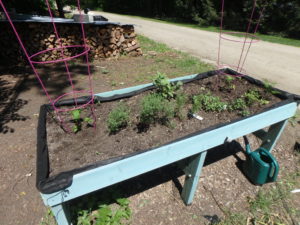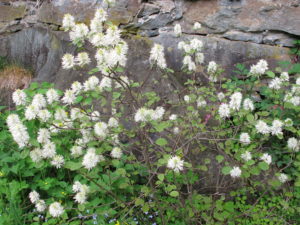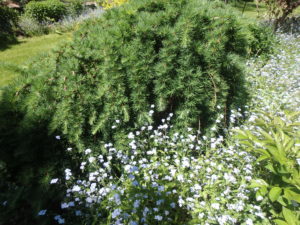Gardening As We Get Older
I reached the age of 72 recently and have been thinking about the future. What will my gardens be like when I’m 82? Will I be gardening at 92? I realize I won’t always have the strength, stamina and energy to manage all I do now. Here are some thoughts about how I shall cope – and my ideas about what to do, starting now.
First, I’ll need to make choices about what flower and vegetable beds I want to keep. Growing lawn is the easiest of all gardening activities. I can see myself riding around on a mower when I can’t bend over easily to weed. And there are plenty of people who will cut the grass for a price. No special knowledge about plants is needed.
So at some point, I can let some beds revert to lawn. There are plenty of people who would be glad to come dig up and take away peonies or delphinium. If I put an announcement in the town list serve, I will find takers. Last fall I dug up some big clumps of phlox and offered them free and I found homes easily. When I want to downsize, I will make the takers do the digging!
Right now I grow 35 to 50 tomato plants a year. I start them indoors, plant them, tie them to tomato cages, cut off diseased leaves, and harvest them. Do I really need so many? We have plenty of good growers in the region, and a number of great food co-ops. I suppose in 10 years I could downsize to a dozen plants or less.
For two summers I’ve had a garden trug, a planting box on legs that I got from Gardeners Supply Company (www.gardeners.com). I have it near the front door, next to the woodpile, with quick access to the kitchen. I grow one or two tomato plants each summer there, along with plenty of lettuce and herbs. It’s waist high, so no bending is required. It’s made of cedar, and I can see using it in perpetuity. It is 6 feet long by 32 inches wide, and 16 inches deep in the middle – fine for tomatoes.
Shrubs are less work to maintain than perennials or annual flowers. Plant them, or have someone plant them, and they will require little – so long as they are not varieties that grow inordinately fast. There are plenty that can go several years without pruning.
One of my favorites is called fothergilla (Fothergilla major). It has nice white bottle-brush blossoms in May and spectacular fall foliage. Mine, after 15 years and very little pruning, is only 5 or 6 feet tall and wide. It’s hardy to Zone 4.I love my weeping larch tree (Larix laricina ‘Pendula’) that grows in a flower bed. Weepers flow and bend, but do not get tall. Mine will never get more than 3 feet tall. The foliage is soft to the touch. Larches do well in wet soils, and are quite salt tolerant.
There are, in fact, dozens of trees and shrubs sold as miniatures. Some of these are just very slow growing (like the lilac ‘Miss Kim, which can get large), while others really will never get tall, even in 25 years. These miniatures do well in flower beds.
Purple foliage is great to add color to a flower bed but I wouldn’t recommend common ninebark (Physocarpus opulifolius) ‘Diablo’ – it grows too fast and gets to be 10 feet tall before you know it. Now there are a couple of miniatures on the market, ‘Tiny Wine’ and ‘Little Devil’. I shall try one or both of those.
Of course, as we get older, it makes sense to hire some help in the garden. I have been lucky to get a teenager who not only likes being outdoors, but likes gardening and knows the difference between a weed and a flower! Even 4 hours a week makes a big difference.
If you can’t afford to have someone helping all summer, perhaps you can get someone to help clean up the gardens in spring and fall. Once beds are weeded out and mulched, the work of maintaining a garden is not too onerous – even for geezers.
I recently re-read Gardening for a Lifetime: How to Garden Wiser as You Grow Older by Sydney Eddison. Sydney is a friend of mine who lives in Connecticut, and has written many fine books. She has lots of good ideas, including the necessity to accept imperfections in the garden.
Many good gardeners are perfectionists. But as we get older, we have to accept that we can’t keep the garden perfect, or at least not without lots of help. It’s important to change one’s attitude as one ages.
Sydney also recommends getting rid of high maintenance plants and letting easy plants dominate. Daylilies, for example, have nice foliage all summer, great blossoms, and are not overly ambitious (Most don’t try to take over space allocated for other plants.) So grow plenty!
As we get older, so do our trees, creating more shade. Embrace shaded areas as weeds are sun-lovers and there are plenty of fine perennials that will do well in shade.
Some day perhaps I’ll retire and have more time for gardening. In the meantime, I’ll just try to downsize a little every year.
Follow Henry’s blog posts at https://dailyuv.com/





